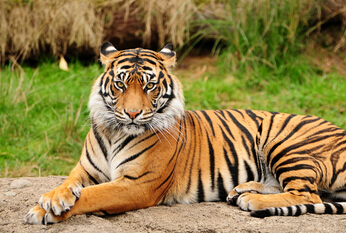For the first time in 100 years, the number of tigers across the world has gone up.
百年来世界上老虎的数量首次上升。
The World Wildlife Fund and Global Tiger Forum say there are now just under 3,900 tigers globally.
世界野生动物基金会和全球老虎论坛表示,现在全球老虎的数量少于3900只。
But their numbers may be increasing in part because they've fallen so far. In 1900, there were reportedly 100,000 tigers.
但它们的数量可能会增加,部分因为其下降如此之大。在1900年,报道称有100,000只老虎。
Still, researchers believe the species' chances of survival are improving.
然而研究人员认为,物种生存的机会正在改善。

A spokesperson for the World Wildlife Fund said, "This offers us great hope and shows that we can save species and their habitats when governments, local communities and conservationists work together."
世界野生动物基金会的一位发言人表示,“这为我们提供了很大的希望,当政府、本地社区和环保人士一起努力,我们可以拯救物种和它们的栖息地。”
Representatives from 13 countries that tigers inhabit are meeting this week. Their goal is to double the world's tiger population by 2022. At the moment, the numbers have stabilized or are increasing in nine of these countries.
来自13个国家的代表本周召开会议。他们的目标是到2022年世界老虎的数量翻倍。目前,数字已经稳定或在这些国家中有九个上升。
Poaching, deforestation and locals fearing for their safety have all played a part in the tigers' decline.
偷猎,砍伐森林和当地人担心他们的安全,是造成老虎数量下降的部分原因。
Conservationists say the problem is even more difficult to overcome because tigers give birth to just two or three cubs every other year, and only about half of all cubs live past the age of 2.
环保人士表示,问题更加难以克服,因为老虎每隔一年只生下两或三只幼崽,只有大约一半的幼崽能活到2岁。
译文属可可原创,仅供学习交流使用,未经许可请勿转载。












